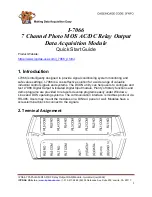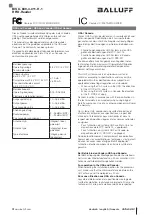
3.0 SYSTEM OPERATION
3-2
CyberCat 254/1016 Operation Manual
UL S2203
Rev 6, 09/2015
P/N: 06-326-2
FM
3.1.4
SILENCE REMINDER
Certain jurisdictions require a silence reminder. This feature requires that the panel produce a momentary
pulse from the panel piezo/buzzer following the silencing of outputs. If this is configured to be ENABLED, the
momentary piezo pulse is ½ second long every 14 seconds on a silenced panel.
3.1.5
STATE COUNTERS
The CyberCat can count states to create an activation of an output. The state counters are created from
Eclipse addressable devices ONLY (e.g., If zone 1 has several alarms, the output can be programmed to
activate upon receipt of 2 alarms total). VESDA does not participate in State Counters.
3.1.6
NETWORK OPERATION
Fike’s CyberCat 254/1016 and Cheetah Xi control panels can be interfaced together to form a common
network of up to 128 panels (network nodes). Each local control panel maintains its own area of protection,
while being able to monitor and control other areas (other network nodes). Each panel can receive, display,
and log all events distributed across the network. In areas where the entire or portions of the network must
be monitored at a central location, each network node(s) can be configured to supervise and display the
status of other selected network nodes.
Network events are transmitted by zone and state. The event is displayed exactly the same on all panels
(nodes). The first 20 characters of the custom message for the device are transmitted across the network to
SUPERVISING controllers only. The peripheral devices do NOT receive custom message information unless
the event comes from the panel where the peripheral is connected.
Network nodes can be configured to either share common zone numbers on the network (e.g., Zone 1
spanning multiple panels operates as one zone for all inputs and outputs), or leave the panel zones
independent from each other (e.g., Zone 1 on panel 1 is independent from zone 1 on panel 2). If the panel is
NOT configured to respond to the zone event that is transmitted, it will respond by logging the event in the
panel’s history buffer and displaying it on the panels display.
Networked panels will synchronize their time and date to what is stored in the “First” panel. This occurs every
24 hours at 12 am.
Two types of network interface modules are available:
•
P/N 10-2482 for connecting panels (nodes) with twisted-pair wire (Refer to Fike Document 06-349,
“Network Module” for more details).
•
P/N 10-2642 for connecting panels (nodes) with fiber-optic cable (Refer to Fike Document 06-387, “Fiber
Optic Network Module” for more details).
Note:
The same type of network interface module MUST be used on all panels connected to a common
network for communication to occur.
3.1.6.1
IP NETWORK
Fike’s Ethernet module (P/N 10-2627) provides a means to connect up to 128 Cheetah Xi and CyberCat
control panels (including 50 points) to an existing IP network for centralized monitoring. As events occur on a
panel that is connected to an Ethernet network, it will transmit its history messages over the facilities Local
Area Network (LAN) or Wide Area Network (WAN) to the supervising (monitoring) panel where the event will
be indicated on the panel display. The Ethernet network only allows one way communication between the
source panel and the supervising panel; therefore, it CANNOT be used for true panel networking as described
in Section 3.1.6 above.
Each panel to be connected to the IP network must have its own Ethernet module and must be configured to
transmit its history events to only ONE supervising panel, which can be located either on or off the premises.
Refer to Fike Document 06-388, “Ethernet Module” for more details.
Summary of Contents for CyberCat 1016
Page 135: ......
















































